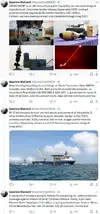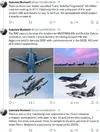Objective 2038: how France will renew its carrier battle group
Directorate: Ministry of the Armed Forces / Published on: November 4, 2024
The carrier battle group (GAN) is an essential pillar of French naval power. In order to always stay one step ahead of technological developments, the Directorate General of Armaments is undertaking, for the benefit of the French Navy, the renewal of the vessels making up the GAN. Starting with its central element: the aircraft carrier Charles de Gaulle. What will change by 2038.
Eleven. This is the number of countries with one or more aircraft carriers (or aircraft carriers) in the world. France is also the only one, along with the United States, to have adopted nuclear propulsion and the technology of catapults and arresting cables, known as "CATOBAR", for this type of ship.
The current carrier battle group
However, the Charles de Gaulle never sails alone. With the ships surrounding it, it forms the carrier battle group (GAN). The latter is made up of frigates that have anti-aircraft and anti-submarine warfare skills. Then there is a force replenishment oiler to refuel, live and spare parts the force at sea. A nuclear attack submarine (SNA) is also inserted into the system. "It is an additional pair of eyes and ears for the GAN. "We are talking about specific sensors and therefore complementary to those of the other means of the naval air group," explains frigate captain Antoine Richebé, former commander integrated within the GAN. But the GAN is also and above all the embarked air group: up to 30 aircraft in total with Rafale Marine, E-2C Hawkeye and Dauphin and Caïman Marine helicopters.
The aircraft carrier of the future
The next-generation GAN is embodied above all by the replacement of its centerpiece. Commissioned in 2001, the "Charles", as sailors call it, is expected to leave the fleet in 2038. A new nuclear-powered giant will then take over.
Artificial intelligence (AI) will obviously be at the heart of the future ship of the French Navy.
"Since we cannot predict the technologies that will come out by then, the challenge is not so much to define the next AI algorithms of the PA-NG. We can, however, determine the concepts of operational use and the link between humans and machines," says Bertrand Rondepierre, director of the ministerial agency for defense AI (Amiad). In short, anticipate the overall architecture so that the latter, once assembled, is not already obsolete.
Suffren-class SNA
The future aircraft carrier will also be able to count on a new generation of nuclear attack submarines (SNA): the Suffren class from the Barracuda program. Two of them have already been delivered. The Tourville, the 3rd submarine in the series, is currently completing its sea trials. The other three SNAs (De Grasse, Rubis and Casabianca) are at different stages of construction and their delivery will be staggered until 2030. Like their Rubis-class predecessors, the new SNAs are equipped with nuclear propulsion, which gives them a remarkable range and discretion. They are also faster, more durable and more versatile. Not to mention their increased capabilities for deploying special forces and for striking in depth, on land targets located several hundred kilometers away, using naval cruise missiles. "More generally, the SNA can go discreetly to observe far ahead and report what it has seen. This ability to project itself for a long time provides valuable advance notice to other units. All the more so with the Suffren-type SNAs, whose sensors are more efficient," says frigate captain Antoine Richebé, former commander integrated into the GAN.
Defence and intervention frigate
While the French Navy can already rely on a format of 8 multi-mission frigates (FREMM), including 2 with enhanced air defence capabilities (FREMM-DA), as well as 2 air defence frigates (FDA), it is awaiting the imminent arrival of its very first defence and intervention frigate (FDI). This programme aims to build 5 FDIs, 3 of which have already been ordered. The objective is to replace the current La Fayette-type frigates (FLF), commissioned between 1996 and 2001. The Admiral Ronarc’h, the first in the series, also made its first sea voyage at the beginning of October, off the coast of Lorient (Morbihan).
This stage marks the beginning of a sea trial campaign that will be conducted under the leadership of the DGA, in conjunction with its state and industrial partners, until the delivery of the ship to the Navy in 2025. The five FDI will contribute to strengthening the fleet of first-rate French frigates, by 2032. "The Admiral Ronarc'h is a real concentrate of technology. It has the capabilities of a destroyer in a frigate frame. In addition, it is the first cybersecured boat by design!", says Yonec Fihey, Marketing Director for Surface Boats and Systems at Naval Group. Last but not least, the FDI will be able to simultaneously embark a helicopter, a drone and receive a detachment of special forces with their two commando boats.
Force supply vessel
The GAN of the future is already partly completed concerning its supply part. The first of the four force supply vessels (BRF) of the "Logistics Fleet" (FlotLog) program, the Jacques Chevallier, was in fact handed over to the French Navy in July 2023. Two other BRFs will be delivered by 2030, in accordance with the LPM. The fourth and last in the series is thus expected by 2035. What will they bring that is new? A greater capacity to carry freight and fuel, but also better tactical capabilities compared to the Durance class ships. As a reminder, these vessels also carry ammunition, spare parts and food.













